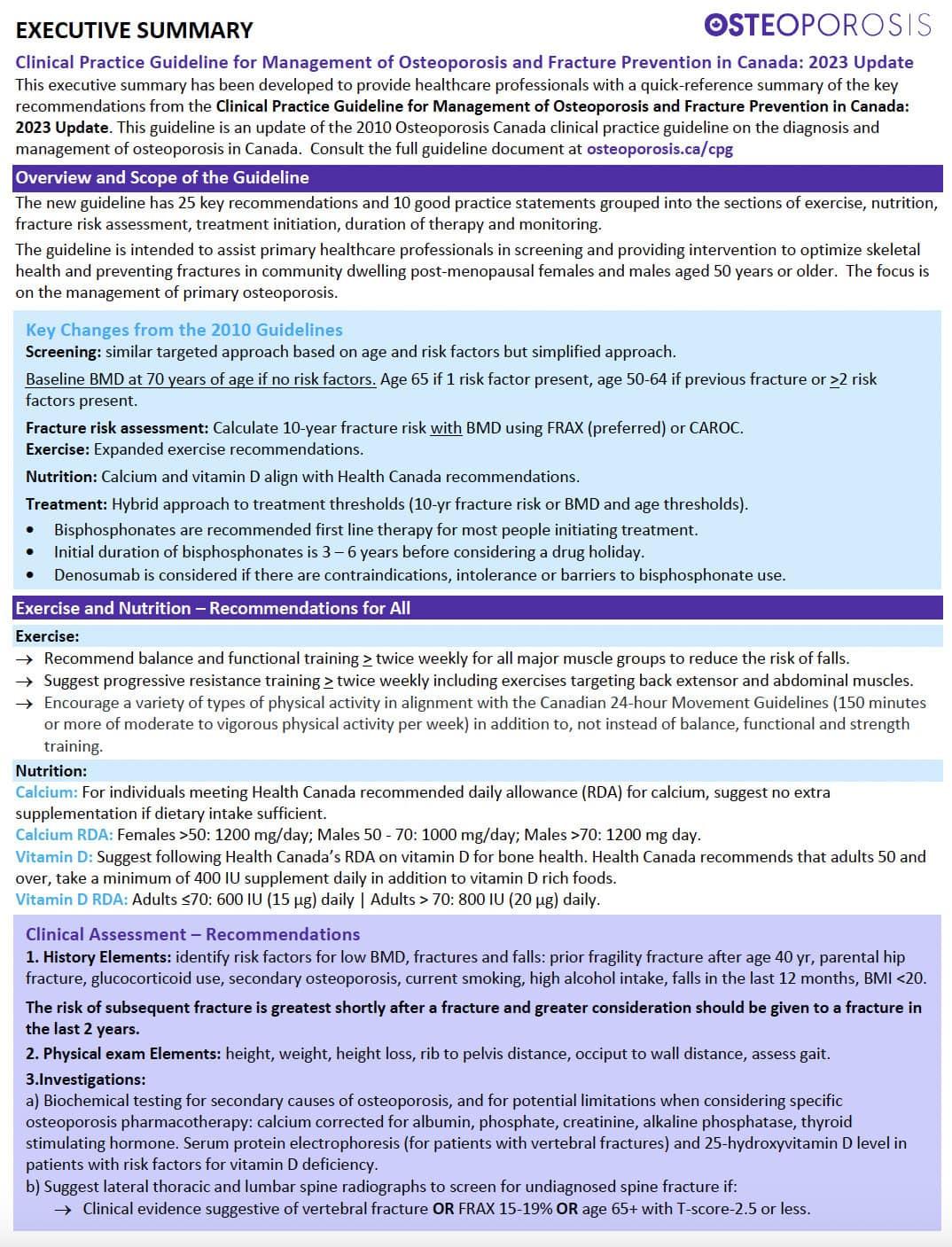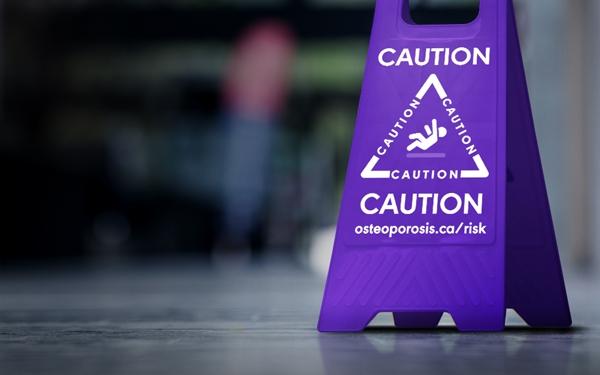
Executive Summary
Clinical practice guideline for management of osteoporosis and fracture prevention in Canada: 2023 update
This executive summary has been developed to provide healthcare professionals with a quick-reference summary of the key recommendations from the Clinical Practice Guideline for Management of Osteoporosis and Fracture Prevention in Canada: 2023 Update.
This guideline is an update of the 2010 Osteoporosis Canada clinical practice guideline on the diagnosis and management of osteoporosis in Canada. Consult the full guideline document at osteoporosis.ca/cpg.
Overview and Scope of the Guideline
The new guideline has 25 key recommendations and 10 good practice statements grouped into the sections of exercise, nutrition, fracture risk assessment, treatment initiation, duration of therapy and monitoring.
The guideline is intended to assist primary healthcare professionals in screening and providing intervention to optimize skeletal health and preventing fractures in community dwelling post-menopausal females and males aged 50 years or older. The focus is on the management of primary osteoporosis.
Key Changes from the 2010 Guidelines
Screening: similar targeted approach based on age and risk factors but simplified approach.
Baseline BMD at 70 years of age if no risk factors. Age 65 if 1 risk factor present, age 50-64 if previous fracture or >2 risk factors present.
Fracture risk assessment: Calculate 10-year fracture risk with BMD using FRAX (preferred) or CAROC.
Exercise: Expanded exercise recommendations.
Nutrition: Calcium and vitamin D align with Health Canada recommendations.
Treatment: Hybrid approach to treatment thresholds (10-yr fracture risk or BMD and age thresholds).
- Bisphosphonates are recommended first line therapy for most people initiating treatment.
- Initial duration of bisphosphonates is 3 – 6 years before considering a drug holiday.
- Denosumab is considered if there are contraindications, intolerance or barriers to bisphosphonate use.
Exercise and Nutrition – Recommendations for All
Exercise:
- Recommend balance and functional training: > twice weekly for all major muscle groups to reduce the risk of falls.
- Suggest progressive resistance training: > twice weekly including exercises targeting back extensor and abdominal muscles.
- Encourage a variety of types of physical activity in alignment with the Canadian 24-hour Movement Guidelines (150 minutes or more of moderate to vigorous physical activity per week) in addition to, not instead of balance, functional and strength training.
Nutrition:
Calcium: For individuals meeting Health Canada recommended daily allowance (RDA) for calcium, suggest no extra supplementation if dietary intake sufficient.
Calcium RDA: Females >50: 1200 mg/day; Males 50 – 70: 1000 mg/day; Males >70: 1200 mg day.
Vitamin D: Suggest following Health Canada’s RDA on vitamin D for bone health. Health Canada recommends that adults 50 and over, take a minimum of 400 IU supplement daily in addition to vitamin D rich foods.
Vitamin D RDA: Adults ≤70: 600 IU (15 μg) daily | Adults > 70: 800 IU (20 μg) daily.
Clinical Assessment – Recommendations
1. History Elements: identify risk factors for low BMD, fractures and falls: prior fragility fracture after age 40 yr, parental hip fracture, glucocorticoid use, secondary osteoporosis, current smoking, high alcohol intake, falls in the last 12 months, BMI <20.
The risk of subsequent fracture is greatest shortly after a fracture and greater consideration should be given to a fracture in the last 2 years.
2. Physical exam Elements: height, weight, height loss, rib to pelvis distance, occiput to wall distance, assess gait.
3. Investigations:
a) Biochemical testing for secondary causes of osteoporosis, and for potential limitations when considering specific osteoporosis pharmacotherapy: calcium corrected for albumin, phosphate, creatinine, alkaline phosphatase, thyroid stimulating hormone. Serum protein electrophoresis (for patients with vertebral fractures) and 25-hydroxyvitamin D level in patients with risk factors for vitamin D deficiency.
b) Suggest lateral thoracic and lumbar spine radiographs to screen for undiagnosed spine fracture if:
- Clinical evidence suggestive of vertebral fracture OR FRAX 15-19% OR age 65+ with T-score-2.5 or less.
Fracture Risk Assessment and Treatment Initiation – Recommendations
- Suggest BMD testing in postmenopausal females and males who:
- are aged 50–64 yrs with a previous osteoporosis-related fracture or ≥ 2 clinical risk factors OR
- are aged ≥ 65 yrs with 1 clinical risk factor for fracture OR
- are aged ≥ 70 yrs with no risk factors.
- Canada specific FRAX tool with BMD is the preferred tool for 10-yr fracture risk estimation. CAROC is an alternate fracture risk assessment tool.
- Treatment thresholds:
- Recommend initiating pharmacotherapy in postmenopausal females and males aged ≥ 50 yrs who:
- have had previous hip, vertebra or ≥ 2 osteoporosis-related fractures OR
- have a 10-yr major osteoporotic fracture risk ≥ 20% OR
- are aged ≥ 70 yrs and have a T-score ≤ −2.5 (femoral neck, total hip or lumbar spine).
- Suggest initiating pharmacotherapy in postmenopausal females and males aged ≥ 50 yrs who:
- have a 10-yr major osteoporotic fracture risk between 15% and 19.9% OR
- are aged < 70 yrs and have a T-score ≤ −2.5 (femoral neck, total hip or lumbar spine).
- Suggest that for individuals who do not meet the threshold for initiating pharmacotherapy or choose not to initiate therapy, BMD testing and fracture risk assessment can be repeated at:
- 5–10 yrs if the risk of major osteoporotic fracture is < 10%
- 5 yr if the risk of major osteoporotic fracture is 10%–15%
- 3 yr if the risk of major osteoporotic fracture is ≥15%
Fracture Risk Assessment and Treatment Initiation – Recommendations
Pharmacotherapy Recommendations: Initiating Therapy, Duration and Monitoring
Initial therapy for people who meet criteria for initiation of pharmacotherapy:
- Recommend bisphosphonate therapy (alendronate, risedronate, or zoledronic acid).
- For postmenopausal females who are < 60 years of age or < 10 years menopause who prioritize alleviation of menopausal symptoms, suggest menopausal hormone therapy as an alternative option to bisphosphonates.
- For people with contraindications, intolerance or barriers to bisphosphonate, suggest denosumab*.
- For people with recent severe vertebral fracture or more than 1 vertebral fracture and T-score < -2.5, suggest seeking advice from an osteoporosis expert on anabolic therapy (teriparatide, romosozumab).
For postmenopausal females who have contraindications or intolerance or choose not to take other suggested therapy, suggest raloxifene rather than no therapy.
*Remarks: Despite the benefits of denosumab, a careful assessment of indications is required because of the risk of rapid bone loss and vertebral fractures with delayed dosing or discontinuation of denosumab. It is important to communicate the need for commitment to long-term therapy and the need to transition to alternative antiresorptive therapy if discontinuing denosumab.
Denosumab doses should be given every 6 months and not delayed no later than one month because of rapid bone loss and vertebral fractures.
Duration of Therapy
- For people on bisphosphonates, suggest initial therapy for 3 – 6 years before considering a drug holiday.
- If concerns of inadequate response during bisphosphonate therapy despite adherence, good practice includes extending or switching therapy, and reassessing for secondary causes.
- For people on denosumab, suggest long-term uninterrupted therapy.
- For people stopping denosumab after <4 doses, suggest transition to bisphosphonate 6 month after the last dose of denosumab to reduce the risk of rapid bone loss. Suggest bisphosphonate therapy for 1 yr and then reassessing the need for ongoing transition therapy.
- For people discontinuing denosumab after ≥ 5 doses where the risk of rapid bone loss or vertebral fractures is high (e.g., those with prevalent vertebral fractures), good practice includes seeking advice from a consultant with expertise in osteoporosis on how to transition to an alternative therapy.
Monitoring of Therapy
- Suggest BMD monitoring 3 years after initiating pharmacotherapy#.
- Three years after stopping bisphosphonate therapy (i.e., drug holiday), suggest repeating BMD measurement and clinical assessment of fracture risk to determine the need for resumption of therapy#.
#Shorter interval for repeat BMD and earlier reassessment if secondary causes, new fracture or new clinical risk factors.



